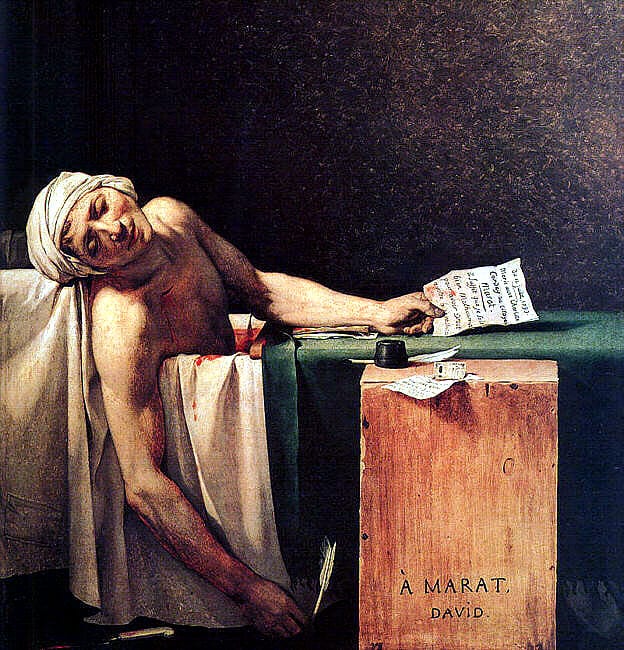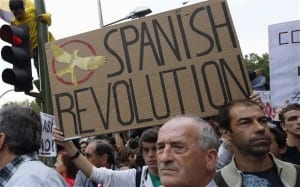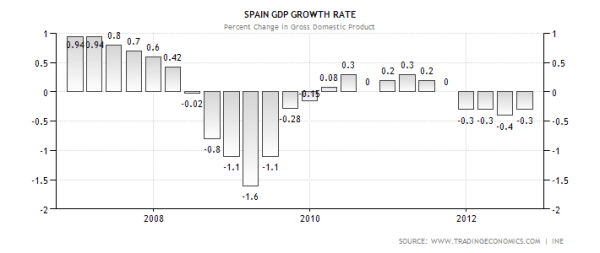OpEds—

Marat: Still relevant?
BY JOOST Van STEENIS
Changing the fundamental paradigms that rule society opens the door to a completely different future.
“Despite their defeats, the princes do not lose anything” (Jean-Paul Marat).
The world is dominated by the 1%, the Happy Few with a surplus of power and money. Despite wars, revolutions, economic and financial crises, natural catastrophes, etc. they rule the world already for ages. Is a world possible where decisions are not taken because of the pivotal role of money but because all people have the same status?
Thomas S. Kuhn wrote in his book “The Structure of Scientific Revolutions: “….when paradigms change, the world itself changes with them. Led by a new paradigm scientists adopt new instruments and look in new places. Even more important, during revolutions scientists see new and different things when looking with familiar instruments in places they have looked before.”
Though his studies concerned the smaller world of science, also in the much more complicated big world unsolvable problems can be solved by applying new paradigms. Then we see things we could not see before. Copernicus could not foresee the influence of his new paradigm expressed in the small sentence: “The Earth is not the centre of the Universe”. The future is unknown but we can take the road to that new future by using a new paradigm, another small sentence that states that “all people have the same status”.
The future is not a simple extrapolation of the present. Extrapolations do not change the basic paradigms that determine our world. The predecessors of Copernicus explained the movements in the sky time and again with new calculations but could not solve many problems by assuming that the Earth was the centre of the Universe. “The failure of the existing rules is the prelude to a search for new ones” (Kuhn). Copernicus wrote in the Preface to the De Revolutionibus that “the astronomical tradition had finally created a monster”. Our society based on the money paradigm has also become a monster in which nearly ten million kids die each year before they are five years old.
This problem cannot be solved when decisions are ruled by money. By adopting a new paradigm this becomes a prime problem. Now it is a secondary one because the kids are not important in the money economy. When the thinking of people is inspired by new principles, the world will start to change.
To open the door to a completely different world we must replace the old assumptions with new paradigms. Advancing on the road to that world is more important than the new world itself. The far future will be organised by people who live then. The transition is determined by a paradigm shift, a catastrophe, a revolution. The Catastrophe Theory of the French mathematician René Thom tells us that predictions are impossible. We can only strengthen the factors that lead to a revolution. When the fundamentals start to change, society will change also. To open the door we need new paradigms as guidelines for human activity.
Most political activities take place inside the borders determined by the money paradigm. Tobin tax, Robin Hood tax or higher taxes for millionaires do not undermine the power relations. It are examples of extrapolating the already known to the future. Such ideas deceive The People by proposing a change that is not fundamental. A new paradigm is necessary to replace the idea that the ruling 1% is the centre of the world and to find unknown action ideas to proceed on the road to the future.
The new paradigm
That all people have the same status should replace the pivotal role of money in all decisions.
The 1% uses the money paradigm to rule.
Who are the 1% and why do they have so much power?
The Theory of the Three F’s (Finance, Function and Family) gives insight. Members of the 1% have a lot of capital at their disposition, the Finance-factor. They have Functions that give them entrance to the decision-making process. And they have Family-members in comparable positions who can provide valuable information that is not available to more common people.
But money is the central factor, money rules the world.
The new paradigm should be applied in any action. Copernicus applied his paradigm and advanced on the road towards a new future without knowing where he would arrive. But it took about 150 year before the new paradigm was widely accepted and only then most scientists had entered the new astronomical world. A new political paradigm in our time with fast electronic means of communication can change the world faster though even now it will take some time before the minds of most people are changed.
When money is not anymore the guiding element in decisions, power relations will change. One of the action targets will be the undermining and destruction of the power-pyramid – causing that the 1% gets the same status as the 99%. The new paradigm: ”All people have the same status” will guide us in our thinking and our activities.
The French Revolution at the end of the 18th century was also guided by new paradigms. The slogan “Freedom, Equality and Fraternity” activated the masses but already some years after the Revolution the paradigm was discarded. The power taken away from old leading groups returned to new leading groups that included parts of the old 1% and The People lost their same status. The new society started to resemble to a great extent the old one with a small group at the top and the masses down below. The paradigm was not carried through and old paradigms got again the upper hand.
Just before the Revolution the Count de Montesquieu introduced the Trias Politica to solve conflicts within the elite. He separated the Judicature, the Executive and the Legislature. The Count used the new paradigm (Freedom, Equality and Fraternity) only for the top of society. The Machiavellian way to decide with a lot of deceit and violence was replaced by the Trias Politica. In the relation between elite and mass, deceit and violence remained the principal way of treating the 99%. Only one part of the Trias Politica, the Legislature, is partly elected, members of the other two parts are nominated by peers. The 1% control all three power instruments and the money paradigm rules the Trias Politica. The Trias Politica is in violation of the status-paradigm.
When all people have the same status all should have independent power instruments. In the system of Montesquieu the 99% have no power instruments to confront top-people. The Trias Politica can only be used by people with money, lawyers are too expensive. The influence of common citizens is minimal, there is no independent Fourth People’s Power and thus not the same status.
Actions should be judged by the question if they contribute to diminishing the power of the few. Actions that do not comply with this idea should not be carried out. Petitions, most demonstrations but also the blowing up of a factory do not bring the same status nearer. The insurance pays the damage and the power structure is not challenged.
Jean-Paul Marat (1743-1793)
Jean-Paul Marat, one of the leaders of the French Revolution, demanded a Fourth People’s Power. Common citizens must not transfer their power to elected officials who decide without further influence from beneath but must have an independent power. He emphasized the Freedom aspect of the new paradigm by stating that ”The only goal is the punishment of the perpetrators of crimes against public and individual freedom…”. That is not guaranteed by the Trias Politica,
Marat was soon murdered and his ideas were afterwards hardly used in revolutionary circles. Paradigms that did not challenge the power relations had hardly success. The life of people after Revolutions improved but in Russia and elsewhere a new 1% arose and society started to resemble societies in the rest of the world.
Marat wanted to protect the achievements of the French Revolution and the new paradigm by Patriotic Clubs to prevent that the old leading class should regain power or that a new 1% could arise. The organisation of society in the time of Marat does not differ principally from the present situation. Our democracy has its roots in the ideas of Montesquieu about the Trias Politica. There still exists a deep separation between the 1% and the 99%. The Trias Politica regulates conflicts inside the 1%. The influence of the 99% is two hundred years after the French Revolution still negligible. We need a Fourth People’s Power!
The ideas of Marat can be distilled from the next quotations:
“Patriotic Clubs will only pay attention to people in the civil services and unite the forces of the people in order to make up for the grievances of citizens. They will punish the agents of the authorities who are guilty, stop the continuation of their bad deeds and safeguard the well-being of the people …… but we will never be a club that is involved in the process of making decisions. That should be a serious mistake: a free union of citizens is not allowed to meddle in public affairs, to govern or to
administrate. That must be clear: a club has only the simple and pure right to make propositions, to give advice and to ask questions. But when the freedom and the safety of the people is attacked it is not only advisor but also agitator, censor, punisher and even killer ……”
“The only goal is the punishment of the perpetrators of crimes against public and individual freedom and safety. Therefore the clubs are not open for people who are attached to the Royal Court, for Queens’ Commissioners, for members of leading academic clubs, for gentlemen of independent means, for captains of finance, for speculators on the bourse, for attorney-generals, for members of the Parisian military
police and for members of the town council. And one should be very careful to admit noblemen, members of the judicature or high army officers…..”
The first quote points at the power to control while rejecting meddling in public affairs or involvement in governing or administrating. Though Marat was in the first place concerned about the public sector, his ideas can also be applied to the private sector. Leaders propose and The People control, accept or reject propositions. Patriotic Clubs are not political parties embedded in the system but independent clubs without paid leaders.
The second quote emphasizes that people with high functions or belonging to the 1% may not become members of Patriotic Clubs, they have their own power instruments.
Temporary Autonomous Clubs
I prefer the name Autonomous Clubs over Patriotic Clubs. It are temporary, alternating minorities of active, interested and involved citizens. They must not degenerate into political organisations that obey the Iron Law of Oligarchy as Robert Michels remarked a hundred years ago about trade-unions. Such institutions will soon be controlled by an elite. When a goal is reached Clubs dissolve and former members return to their private life or join another Club to control, correct and punish.
Only people without power may belong to Autonomous Clubs. A multitude of such Clubs form the new controlling Fourth People’s Power. The three separated powers of Montesquieu increased the freedom of the leading class, the new autonomous People’s Power will increase the freedom of common citizens. The paradigm of the French revolution again becomes alive.
Autonomous Clubs challenge decisions taken by selfish leaders. The goal is to control and veto decision-takers and punish faulty ones who are immune against any influence from the masses. This can be achieved by putting pressure on the private life of decision-takers on the time, the place and the how the activists choose. This also complies with the status-paradigm. The 1% harasses the 99%, we should return the gesture. The dynamics of many unpredictable Clubs will fundamentally change society and a new Humane World will arise in which all people have the same status.
The new paradigm has great influence on activities of the 99% who put pressure on the 1% who think they have a higher status. The status-paradigm leads also to the golden action rule that “actions should minimise damage to the 99% and maximise pressure on the 1%”.
The actions Marat proposed comply with the new paradigm and the golden rule. He said: “Revolution will be a kind of guerilla in which we can attack the enemy in all places where the army cannot be used. This means that we can deprive the enemy of all his advantages”.
A long series of small successes undermines the power of the 1%. Power and money are hand in glove. While power is a vague concept and difficult to attack, money expresses itself in worldly goods. The huge differences in income and wealth clearly contradict the status-paradigm. Money should become the principal target to reach the Human World. By preventing the use of vast amounts of money, the necessity to amass the filthy lucre will disappear. When the reason (and the possibility) to have a vast surplus of money is taken away, the effect of the possession of money (resulting in having power and a higher status) will lose its basis in society.
Simply said actions should prevent the 1% to use extravagant goods and services. The slogan “Spending 200.000 euro in one year should be the limit!” (200.000 euro is an arbitrary amount) makes all goods and services that cannot be bought or used by “200.000 minus people” action targets. To escape the continuous pressure from down under on their private living situation the 1% will take different decisions. The actions are like a War of the Flea, harassing people like fleas do. Many small actions disturb their quiet and extravagant life and the fleas will hardly be hurt.
“The Flea bites, hops and bites again, nimbly avoiding the foot that would crush him. He does not seek to kill his enemy at a blow but to bleed him and feed on him, to plague and bedevil him, to keep him from resting and destroy his nerve and morale………… All this requires time. Still more is needed to breed more flees. What starts as a local infection must become an epidemic, as one by one the areas of resistance link up, like spreading ink spots on a blotter”. (Robert Taber, The War of the Flea)
Mass actions mostly failed to give the 99% more freedom and do not agree with the status-paradigm. Imprisoned, wounded or killed activists are contrary to the idea that all people have the same status. Mass actions in town centres or in front of government buildings hardly challenge the power of the 1% and certainly not their money and wealth. In big demonstrations only the text on the placards differs, protesters behave in the same way contrary to having the same status. People are different, should have the possibility to act and think on their own way and contribute independently to the struggle.
A world without a 1% demands that the present 1% start to lose their power. In the end they will have the same status as all other people. The new paradigm does not speak about dead instruments of power but about living people who should get the same status. Though sometimes power instruments of the 1% may be attacked, most actions against banks or other symbols of power are not in accordance with the paradigm that turns around living people and not around dead institutions.
In smaller groups people have the same status, using their own capabilities, characteristics and creativity in actions. Some spread flyers in the neighbourhood of the targeted 1% with texts that disclose their criminal and greedy activities. Others disturb his exclusive clubs or expensive restaurants. Or remove the most beautiful flower from his garden to replace it in a park where everyone can see it. Or invade his second, third or fourth house, throw a rock through a window, puncture the tire of an extravagant car, or order a wagon load of earth or hundred bottles of an expensive wine (without paying of course). The Club will disconnect the target from all contacts he needs to exercise power.
The concept of Creative Disturbance of the exclusive life of the 1% complies with the idea that all people have the same status which means that nobody has the moral right to have an extravagant life – at the cost of the life of other humans [and the planet itself]. Because of the continuous – and increasing – pressure on the 1% their minds will be influenced by the idea that nobody has the right to have a different status and that getting or using too much money will be prevented. When money is replaced by the idea that all people have the same status, decisions change. Leaders will not anymore be influenced by the idea of getting more money but by the idea that people are the most important item there is, that they all have the same status.
Autonomous Clubs control if decisions are compatible with the new paradigm and veto wrong ones. In the end they will punish selfish faulty leaders.
The new world with autonomous people will be beautiful.
Joost van Steenis
Joost van Steenis is a veteran activist from The Netherlands who among other things took part in the Provo, Squatters and Anti-nuclear Movements.
Blog of Joost van Steenis: http://downwithelite.wordpress.com “Take the power and the money away from the 1%”
Joost van Steenis, “From Chaos to Change, entering a new era”, free to download from the site “Down with any elite” http://members.chello.nl/jsteenis
Facebook “Occupy the 1%”
Thomas S. Kuhn, “The Structure of Scientific Revolutions”,
Jean-Paul Marat, “Les Chaines de l’esclavage”
Robert Michels, “Les Parties Politiques”
Robert Taber, “The War of the Flea”
René Thom, “Paraboles et Catastrophes”









